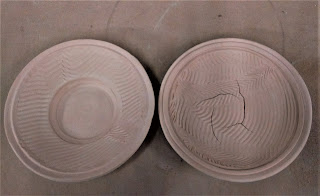This is for the clay students reading this blog. I know you are out there!
My upside down plates have come out of the bisque, and guess what? One of them cracked pretty spectacularly. I sort of thought it might. Anyone care to hazard a guess as to why the one cracked and the other didn't?
Turn your computer upside down for the answer!
Actually, there's a bit more after the break.
I couldn't compress the center of the plate on the right sufficiently, because if I did, I would have disturbed the texture. As a result, the clay platelet were aligned side-on, in a circular pattern, as happens when throwing. This configuration allows many places for cracks to start between the platelets. Compression - light sweeping pressure on the surface - will align the platelets more like bricks in a wall, so it is harder for a crack to begin. It really only affects the platelets on the very surface, and when I cut the plate away, I revealed the interior clay - which hadn't and couldn't be compressed.
There is surely a way around this: compression via q-tip? Cutting with a stiff wire, so it might compress as it goes? Still cogitating on it.
It's the Guns
17 hours ago









4 comments:
uneven drying
Insufficient compression.
Bummer, too. I liked that one.
Making them upside down sounds cool, but it sounds like you have to be even more careful about getting cracking like s-cracks from lack of compression. I don't even know if that qualifies as an s-crack so much as a 'whole-alphabet-crack'.
LOL, that sounds about right.
Post a Comment